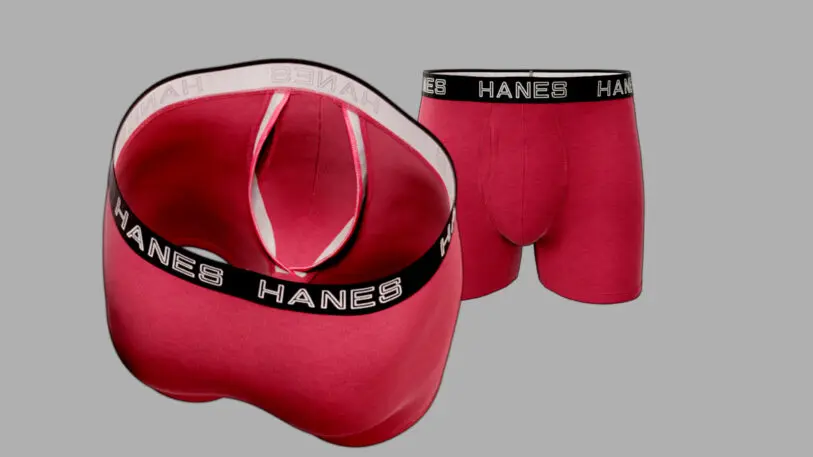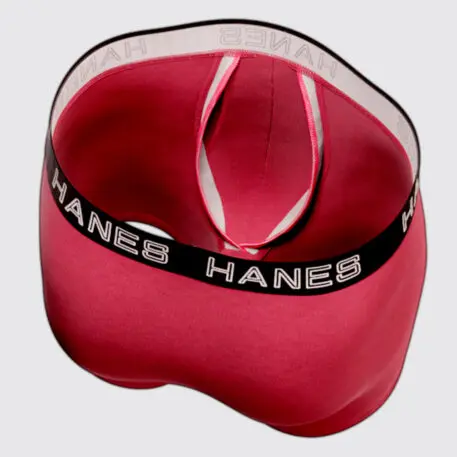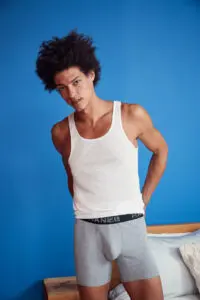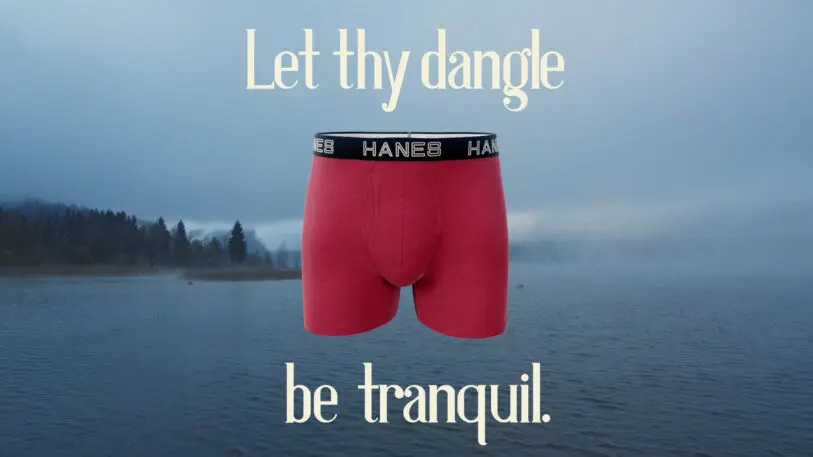Boxers or briefs. It’s the age-old question for men. Or it was. Now, Hanes is asking a new question: pouch or no pouch?
Today, Hanes is launching its biggest new product in years. It’s called the Hanes Comfort Flex Fit Total Support Pouch. As my editor suggested with all the subtlety of Shakespeare, it’s “a bra for your balls.” After talking to the Hanes team and wearing the underwear myself for a few days, I can tell you she’s right.
Developed over the course of two years, the Total Support Pouch is a patent-pending design that looks like a tiny crossover bra inside your boxer briefs. On the package, the product promises to “separate and support”—in other words, to lift your genitalia away from your body for a more comfortable fit.

“They’re very expensive, not widely distributed,” says Jaye Powell of these competing pouch products; she’s the VP and GM of men’s underwear and socks for Hanesbrands. “There’s not a great consumer awareness around it.”
Indeed, I realize this may come as a surprise, but men aren’t thinking about their crotch all day. Once you put on just about any pair of underwear, it all pretty much feels figured out. You don’t want to wear loose boxers to play basketball, because that could be very uncomfortable, but that’s about it.
The handful of friends I spoke to for this article shared that they generally wear boxer briefs, which don’t lift anything up but effectively Ken doll your body in place. None of them complained that their genitalia flopped around under day-to-day conditions. However, one friend mentioned occasional chafing in hot weather. Another shared his latent fear that, as he grows older, his scrotum might lose elasticity and he’d sit on it—which can actually happen as men grow older and the collagen in their skin breaks down.
These sorts of responses are not surprising to Hanes. “Men can tell you the basics that they want in underwear: soft fabric and a nice waistband,” Powell says. “But when you get into how to construct a product, they can’t say.”
Developing the product
Hanes put together a team of five designers and four seasoned pattern-makers to study the category and begin prototyping how a Hanes pouch might work. They identified all sorts of approaches to pouch construction, ranging from athletic cups to pockets to an internal bag or tube, or something worryingly called “inside keyhole support.”
What they ultimately concluded was that most pouches offered lateral support, which controlled genitalia moving from side to side, but not much support beneath the scrotum. And the Hanes team felt that if it could lift this anatomy, it would lead to more overall comfort, along with less sweating and chafing.

What the team settled on was a crossover, bra-style design. Two mesh panels, which look a lot like the perforated fabric in basketball shorts, slide right up under your scrotum. A light stretch tape adds elasticity to the stitching. Once they landed on a general design, the Hanes team tested various permutations in longer-term fit tests with a focus group of 60 people with various body types to validate and refine the design.

After spending a few days with the product, walking, working, Netflixing, and riding my bike, I found that the Hanes pouch design is generally comfortable, and definitely delivers on that promise to support and separate. I could imagine wearing them for rigorous activities. The luxuriously soft polyester blend—which is more premium than what’s in most Hanes—rivaled my pricier, cotton-blend Calvin Kleins.
However, I’m still unsure of how well they would breathe in the heat of the summer. The scrotum naturally loosens when it’s hot, allowing the testicles to cool, and the pouch doesn’t let this happen. And for my own anatomy, the support was sometimes too tight and tailored to feel relaxed when lounging on the couch. I grew a new empathy for women everywhere who pull off their bra the moment their day is done.
[Photo: Hanes]
Selling support
My experience with the Total Support Pouch doesn’t seem to line up with Hanes’s own data, however. After the test with 60 people, the company says it received off-the-charts praise. Eighty percent of men across all tested age ranges reported they both planned to buy the product and recommend it to a friend. Hanes says that feedback confirmed the company was onto something big—something that would be worthy of a sizable marketing push.
But the marketing will be a challenge. Mainstream marketing has traditionally steered clear of penis and testicle talk. Even Viagra and Cialis commercials dance around the realities of male anatomy. Modern men’s brands like Hims have attempted slick branding on topics like erectile dysfunction and baldness, but even that lacks the specific anatomical guidance you’ll find in products marketed to women. Tampon and pad commercials touting wings and absorption are commonplace in our culture, but the men’s playbook isn’t so set: “I think communication is the hardest on this,” Powell says. “How do you talk about it? How do you name it?”
The team’s first thought was to just parody it all, and so they began market testing joke positioning. (Brands like Manscaped come to mind.) “We said we should name it something funny and catchy. We tested ‘Man Cave” [and some] out-there naming,” Powell says. “It didn’t resonate. [Men] wanted to know, what exactly are you doing here?”

Hanes’s new mascot is a Scandinavian man named Hans. He lies with both his shirt and crotch open and orates with an unshakable, unwarranted confidence that sits halfway between the Old Spice guy and a Will Ferrell character. He’s meant to be “funny and engaging and not offensive,” Powell says, and indeed, you can almost imagine the strategy meeting in which a boardroom of execs homed in on just the right culture to appropriate without appearing to be punching down.
The Hanes Comfort Flex Fit Total Support Pouch is available nationwide at retailers starting today. Each pair will cost $6 to $10.
Recognize your brand’s excellence by applying to this year’s Brands That Matter Awards before the early-rate deadline, May 3.
